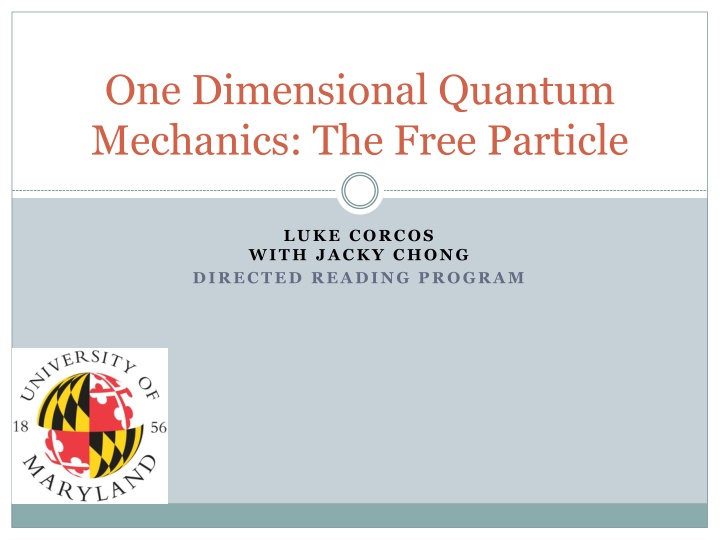
Quantum Mechanics: Free Particle Dynamics and Spectrum
Explore the behavior of free particles in quantum mechanics through the Schrödinger equation, Hamiltonian operators, and the dynamics of momentum representations. Delve into the spectrum of free particles and their development over time.
Download Presentation

Please find below an Image/Link to download the presentation.
The content on the website is provided AS IS for your information and personal use only. It may not be sold, licensed, or shared on other websites without obtaining consent from the author. If you encounter any issues during the download, it is possible that the publisher has removed the file from their server.
You are allowed to download the files provided on this website for personal or commercial use, subject to the condition that they are used lawfully. All files are the property of their respective owners.
The content on the website is provided AS IS for your information and personal use only. It may not be sold, licensed, or shared on other websites without obtaining consent from the author.
E N D
Presentation Transcript
One Dimensional Quantum Mechanics: The Free Particle LUKE CORCOS WITH JACKY CHONG DIRECTED READING PROGRAM
Books Lectures on Quantum Mechanics for Mathematics Students by Faddev and Yakubovskii Modern Quantum Mechanics by Sakurai
Introduction Quantum mechanical behavior is described by the Schr dinger equation: ( ) d t = ( ) ih H t Time Dependent: dt ( = ) ( ) H t E t Time Independent: E=Energy; h=Plancks constant
Introduction 2 P ) Q = + ( H V Hamiltonian: 2 m Coordinate Representation Momentum Representation Q = ( ) ( ) Q x x x = ( ) ( ) Q p ih p p P h = ( ) ( ) = P x x ( ) ( ) P p p p i x Q= Position Operator P= Momentum Operator
Free Particle (V=0) 2 P 2 H When V=0: = m Let s first look at solution of the Time-Independent Schr dinger Equation and solve for the spectrum of the Hamiltonian Operator 2 P 2 = E = E H m
Spectrum of Free Particle h = In the coordinate representation: ( ) ( ) P x x i x 2 2 2 2 P 2 h 2 d So = E = E m m dx For simplicity, define units such that h=1 and m=1/2 k = 2 Define the wave number k>0 s.t. E
Spectrum of Free Particle + k = 2 ' ' 0 So = ikx ( ) x Ce which has solutions: k 2 ( = Now Normalize: * ' ikx ik x ) ( ) x x dx C e e dx ' k k Using the property of Fourier Transforms 1 2 2 = 2 = ' ikx ik x ( ) ' k C e e dx C k C 2
Free Particle Dynamics To understand how the Free Particle develops with time, we now shift to the Time-Dependent Schr dinger Equation ) ( dt d t = ( ) ih H t For simplicity, let s start with the momentum representation: P = ( ) ( ) p p p
Free Particle Dynamics ( dt , ) d p t = 2 ( , ) i p p t 2dp = =1 ( ) 0 , p ( ) p ( ) p Where and 2 = ip t ( , ) p t Ce The Solution: = = ( ) 0 , p ( ) C p 2 = ip t ( , ) ( ) p t p e
Free Particle Dynamics Now we put the solution into the coordinate representation using the Inverse Fourier Transform 2 2 = = 1 1 1 ip t ip t ( , ) [ ( ) ] [ ( )] [ ] x t F p e F p F e 2 x 4 1 i 2 = = 1 1 ip t [ ( )] ( ) F p x [ ] F e e t 2 it
The General Solution ( ) 2 4 x y 1 = ( , ) ( ) x t y e dy it 2 it
Approximation of Long Term Dynamics 2 = 1 ip t ( , ) [ ( ) ] x t F p e 1 2 = ( ) i px p t ( , ) ( ) x t p e dp 2 px 1 2 ( ) it p = ( , ) ( ) x t p e dp t 2 Let s now use the stationary phase approximation to look at the dynamics as t
Stationary Phase Approximation This method approximates integrals of the form b a N = ( ) iNf x ( ) ( ) I N g x e dx This has the solution 1 2 2 1 i ~ ~ ~ = + + ( ) ( ) exp[ ( ) sgn ( ' ' )] I N g x iNf x f x O ~ ( ' ' ) 4 N x~ f x N = Where is the point where ( ' ) 0 f x
Approximation of Long Term Dynamics px 1 2 ( ) it p = ( , ) ( ) x t p e dp t 2 px x 2 ~= N = = 2 t ( ) f p p p t t 2 x 4 1 1 x 2 as ( ) i t = + ( , ) ( ) x t e O 4 t t t 2 t
Consequences 2 x 4 1 1 x 2 ( ) i = + ( , ) ( ) x t e O 4 t t t 2 t x 2 = p 1. The point of stationary phase occurs at So recalling that m=1/2, the classical momentum equation is realized. 2. so ) ( ) , ( t , ( t x t p = mv 1 C = x t O ( , ) x t t 2 t ) 0 This implies as
Source: https://en.wikipedia.org/wiki/Wave_packet#Free_propagator






















